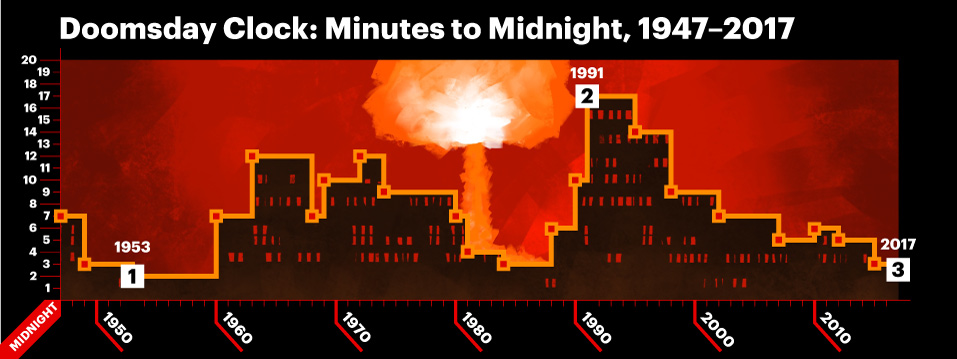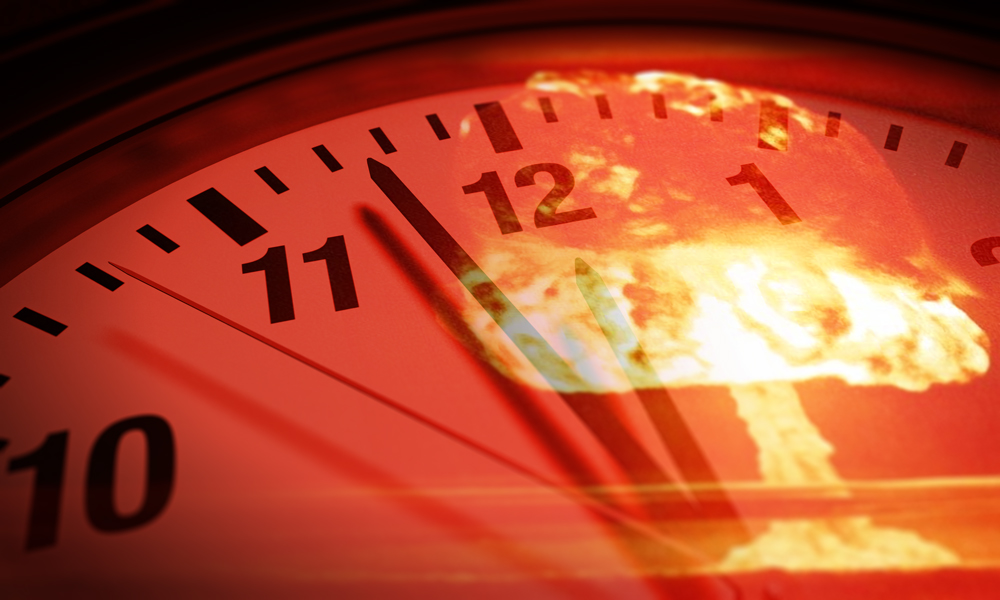With tensions running high amidst the continued North Korean nuclear threat, members of the Bulletin of the Atomic Scientists are getting ready for their annual meeting in Chicago on November 6. The group of experts on nuclear policy, climate change, and other potential global hazards, is better known as the keeper of the “Doomsday Clock,” the near-universally recognized minimalist representation of the likelihood of a man-made worldwide catastrophe—with midnight marking the terminus, the point of imminent disaster.
Back in January, the scientists moved the clock’s minute hand 30 seconds closer— to 2 ½ minutes to midnight—to signal their concern over increasing threats of nuclear weapons and climate change, as well as President Trump’s pledges to impede what the scientists saw as progress on both fronts.
The current setting is the clock’s second closest to midnight since its introduction in 1947. (The closest the clock ever came to doomsday was in 1953 after the United States and the Soviet Union each conducted tests of the hydrogen bomb, which is far more powerful than any atomic bomb, triggering a 2-minutes-to-midnight setting.)
Unsurprisingly, given the urgency of the Bulletin’s current clock setting, the scientists’ agenda this year sounds like a laundry list of modern nightmares: from the state of nuclear weapons in the 21st century and existential cyberspace threats, to the safety of our biodefense and climate change.
“Once North Korea combines nukes and their delivery systems, in particular intercontinental ballistic missiles, it would have the ability to retaliate anywhere and anytime,” says Hein Goemans, a University of Rochester associate professor of political science and an expert on why nations go to war. Goemans worries that if North Korea makes a coercive threat against South Korea or Japan, “it might make sense for the US to try to forestall North Korea from getting that ability.”

(1) 1953: The Clock’s closest approach to midnight—the US tests its first hydrogen bomb in November 1952, before the Soviet Union follows suit in August.
(2) 1991: The Clock’s furthest setting away from midnight—the US and Soviet Union sign the first Strategic Arms Reduction Treaty (START I), followed by the dissolution of the Soviet Union on December 26.
(3) 2017: The second-closest setting to midnight—rise of nationalism, US President’s comments over nuclear weapons (including North Korea), the threat of a renewed arms race between the US and Russia, and the expressed disbelief in the scientific consensus over climate change by the Trump Administration.
(University of Rochester illustration / Michael Osadciw)
At the clock’s inception 70 years ago, its creators—Manhattan Project scientists who felt they could not remain aloof to the consequences of their own work—were primarily concerned with the impending nuclear arms race between the US and the Soviet Union. But by 2007, the scientists had included possible catastrophic disruptions from climate change in their clock-setting deliberations.
According to Thomas Weber, an assistant professor of earth and environmental sciences at Rochester, that decision was a sound one. He agrees with the assessment of the Intergovernmental Panel on Climate Change (IPCC) that climate change will likely impose “severe, pervasive and irreversible impacts on humans and ecosystems” over the coming century. The IPCC predicts that without additional efforts to curb greenhouse gas emissions, the global temperature (relative to the pre-industrial era) will increase by 4 degrees Celsius (7.2 degrees Fahrenheit) or more by the year 2100. And that means heat waves and heavy precipitation will become increasingly common in densely populated mid-latitude regions. “These trends are expected to undermine food security and result in widespread population displacement, particularly in developing countries,” Weber cautions.
From his own research in chemical oceanography, along with data from a number of recent studies, Weber points out that some negative consequences of greenhouse gas emissions and warming “are manifesting faster than previously predicted,” including ocean acidification and oxygen loss, which are expected to affect “a large fraction of marine species if current trends continue unchecked.”
Recent findings, Weber says, also suggest that “global sea level rise has previously been under-predicted, and might exceed 5 feet by 2100, increasing the threat of flooding for large coastal cities.”
What’s to be done?
A lot, says Weber—and time is short. In order to mitigate the most severe consequences, global warming would have to be held below 2 degrees Celsius (3.6 degrees Fahrenheit). But that would require aggressive reductions in greenhouse gas emissions—a 50 percent reduction over the next few decades, according to the IPCC. “Recent developments, including the US’s announced withdrawal from the Paris Climate Accord, and a report finding that few countries will honor their emissions pledges, suggest we are not currently on track to meet this goal,” says Weber.
Meanwhile, the Doomsday Clock—according to its keepers “a metaphor, a reminder of the perils we must address if we are to survive on the planet”—keeps ticking.
How high is the current risk level?
“Way too high,” says Goemans. “I know some former very high-ranking military leaders who favor a preemptive strike against North Korea before they have fully operational ICBMs.”
Once again, B-52 bombers have been made 24-hours operational again (after more than a decade of standing down), and three aircraft carriers are currently in, or steaming toward the region.





